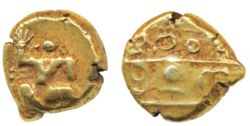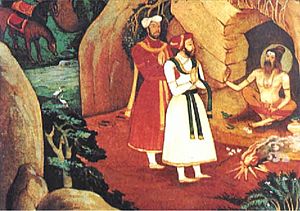Bukka Raya I facts for kids
Quick facts for kids Bukka Raya I |
|
|---|---|

Pagoda of Bukka Raya I
|
|
| Vijayanagara Emperor | |
| Reign | 1356 – 1377 (unofficial) |
| Predecessor | Harihara I |
| Successor | Harihara II |
| Died | 1377 CE Vijayanagar, Vijayanagara Empire (modern day Hampi, Karnataka, India) |
| Issue | Kumara Kampana Harihara II |
| House | Sangama |
| Father | Bhavana Sangama |
| Mother | Maravve Nayakiti |
| Religion | Hinduism (until 1323; 1334 - 1377) Sunni Islam (1323 - 1334) |
Bukka Raya I (ruled from 1356 to 1377 CE) was an important emperor of the Vijayanagara Empire. He belonged to the Sangama Dynasty. His father was Bhavana Sangama, a leader of a cowherd community. Bukka Raya I helped his brother, Harihara I, build and expand the Vijayanagara Empire.
Contents
How the Empire Started
The early lives of Bukka and his brother Harihara are not fully known. One popular story says they were commanders for the Kakatiya King of Warangal. When the King of Warangal was defeated, Bukka and Harihara were captured. They were taken to Delhi and became Muslims.
Later, they escaped and returned to their Hindu faith. They were inspired by a wise teacher named Vidyaranya. With his guidance, they founded the Vijayanagara Empire. This new empire became a strong power in southern India.
Bukka Raya's Rule and Expansion
Bukka Raya I ruled for about 21 years. During his time, the Vijayanagara Empire grew much larger and stronger. He conquered many kingdoms in southern India.
Conquests and Victories
- By 1360, he defeated the Shambuvaraya Kingdom and the Reddis of Kondavidu. He also took control of the area around Penukonda.
- In 1371, Bukka defeated the Sultanate of Madurai. This victory extended his empire far south, all the way to Rameswaram.
- His son, Kumara Kampana, helped him in these battles. Their brave actions were written down in a Sanskrit book called Madura Vijayam. It was written by Kumara Kampana's wife, Gangambika.
- By 1374, Bukka gained control over the rich Tungabhadra-Krishna river area. He also took Goa.
- He even made the Jaffna kingdom in Ceylon (modern-day Sri Lanka) and the Zamorins of Malabar pay him tributes.
Clashes with Bahmani Sultans
Bukka Raya I also had conflicts with the Bahmani Sultans. These were powerful Muslim rulers to the north. He fought against Mohammed Shah I and later Mujahid Shah Bahmani.
Moving the Capital
During Bukka Raya's rule, the capital of the Vijayanagara Empire was moved. It was set up at Vijayanagara, on the south side of the Tungabhadra River. This location was safer and easier to defend than their old capital at Anegondi.
Culture and Welfare
Even with all the wars, Bukka Raya I supported many improvements within his empire. He also encouraged learning and literature.
Support for Scholars
- He appointed the famous Telugu poet Nachana Soma as his court poet.
- Many scholars worked under the guidance of Vidyaranya and Sayana.
- With Bukka's support, a group of scholars led by Sayana wrote important explanations of the Vedas. The Vedas are ancient Hindu holy texts.
Bukka Raya I died around 1380. His son, Harihara II, became the next emperor.
| Preceded by Harihara I |
Vijayanagar empire 1356–1377 |
Succeeded by Harihara II |
See also
 In Spanish: Bukka I para niños
In Spanish: Bukka I para niños 


